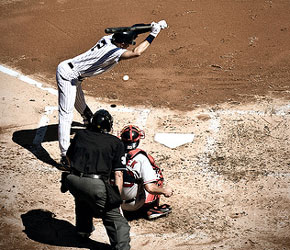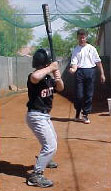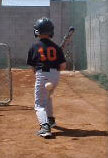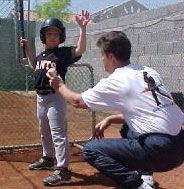Avoiding The Inside Pitch

 More often than not, a young hitter’s lack of success at the plate can be directly attributed to the fear of being hit by a pitched ball. Let’s face it, in the Little League Majors Division, a big 12 year old can throw the ball extremely hard from 46 feet. This can lead to intimidation, a very real fear of being hurt and a lot of weak swings that result in strike outs!! The diminishing confidence that follows continued failure in front of the coach, teammates, friends, Mom, Dad, Grandma and Grandpa can only hurt the player’s next appearance at the plate. All this from being afraid of the ball.
More often than not, a young hitter’s lack of success at the plate can be directly attributed to the fear of being hit by a pitched ball. Let’s face it, in the Little League Majors Division, a big 12 year old can throw the ball extremely hard from 46 feet. This can lead to intimidation, a very real fear of being hurt and a lot of weak swings that result in strike outs!! The diminishing confidence that follows continued failure in front of the coach, teammates, friends, Mom, Dad, Grandma and Grandpa can only hurt the player’s next appearance at the plate. All this from being afraid of the ball.
A good coach knows that this spiraling effect needs to be curbed right at the beginning. The best approach is to immediately demonstrate the proper way to avoid being hit by a pitch. The knowledge of the proper technique can do wonders for a player’s self esteem, not to mention his playing ability. Confidence is one of the key factors in a successful at-bat. If a player confidently approaches the plate looking for a pitch to hit instead of being hit by a pitch, he has already increased his chances by leaps and bounds.
With this in mind, take the time to learn the proper technique of Avoiding The Inside Pitch. It will make you a better hitter!
My preferred method of teaching this technique is to use the softer IncrediBalls made by Easton . With these balls the coach can actually “plunk” the batter a few times without injuring him. It is important for the player to be hit a few times in order to accept the fact (psychologically as well as physically) that :
1.) It doesn’t hurt that bad.
2.) The pain does go away.
3.) The proper technique allows for even less pain
 Have the player enter the Batter’s Box. Stand a few feet away from the player with an IncrediBall (or other soft ball) and hold the ball up. Walk the ball to the plate on an inside path toward the batter. This will give the player a good visual picture of the pitch he wants to avoid. The “walking” of the pitch effectively slows down the action enough to instruct the player in the proper steps to avoid the pitch safely. As the ball is nearing the plate have the player verbally alert you the moment it is apparent the ball is going to be too close to him to be a strike and a pitch he wants to avoid. You can use the command: “NOW!” The coach should stop at this point. Instruct the player to do the following:
Have the player enter the Batter’s Box. Stand a few feet away from the player with an IncrediBall (or other soft ball) and hold the ball up. Walk the ball to the plate on an inside path toward the batter. This will give the player a good visual picture of the pitch he wants to avoid. The “walking” of the pitch effectively slows down the action enough to instruct the player in the proper steps to avoid the pitch safely. As the ball is nearing the plate have the player verbally alert you the moment it is apparent the ball is going to be too close to him to be a strike and a pitch he wants to avoid. You can use the command: “NOW!” The coach should stop at this point. Instruct the player to do the following:
1.) Immediately turn his upperbody (from the waist up) away from the pitch.
2.) The head and shoulders act as one unit turning away.
3.) The shoulder nearest the ball should rise up a little to protect the face.
4.) The elbows drop in close to the sides to protect the ribs.
5.) The chin dips down to the chest to protect the neck from a direct impact.
6.) The bat lowers directly in front of the players upper body.
 All of the above actions take place in one simultaneous motion as the player is rotating away from the pitch.
All of the above actions take place in one simultaneous motion as the player is rotating away from the pitch.
Now, continue walking the ball toward the hitter and show him how protected he is while in this position. Walk the player through this sequence a few times until they feel comfortable with the maneuver. Once they tell you they are ready to move to the next step then proceed with the following drill.
Hitting Drill
Kneel about 20 feet from the player. With an IncrediBall (or other soft ball) begin softly tossing the ball into the strike zone. Let the player know before hand that he may be hit by a pitch, albeit a soft one. Instruct him to turn away from the pitch, in the manner he has been taught, the moment he identifies the pitch as being one that may hit him. Conversely, have the player yell out “NOW!” when he recognizes the pitch as being a strike (this is a great tactic to help a player recognize a pitch he can hit). Throw a few soft strikes and then progressively move the pitches closer and closer to the player until you finally strike him (aim for the buttocks). Praise the player for every pitch he properly turns away from (or properly calls a strike – purposefully throw a few outside pitches to see if he mislabels them as strikes).
 If at any time during the instruction the player reverts to the age old “jumping back with the hands in the air” technique of avoiding a pitch, immediately stop and have the player freeze in that awkward position. Then walk the pitch up to him and show him how vulnerable he is to injury in that position.
If at any time during the instruction the player reverts to the age old “jumping back with the hands in the air” technique of avoiding a pitch, immediately stop and have the player freeze in that awkward position. Then walk the pitch up to him and show him how vulnerable he is to injury in that position.
 Continue with the drill until you see the player begin to naturally turn away from every pitch that is questionably inside. Repeat the drill periodically, even when you know the player is completely comfortable with the technique. I guarantee you will see a tremendous increase in the player’s confidence and performance as he masters this very important fundamental skill.
Continue with the drill until you see the player begin to naturally turn away from every pitch that is questionably inside. Repeat the drill periodically, even when you know the player is completely comfortable with the technique. I guarantee you will see a tremendous increase in the player’s confidence and performance as he masters this very important fundamental skill.
